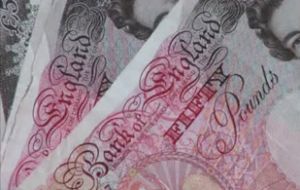MercoPress. South Atlantic News Agency
Bank of England pumps an additional £ 50 billion to the economy
 Quantitative easing expansion since the UK recession “appears to have been deeper than previously thought” and “lending to business has fallen”.
Quantitative easing expansion since the UK recession “appears to have been deeper than previously thought” and “lending to business has fallen”. The Bank of England’s Monetary Policy Committee decided on Thursday to maintain the official bank rate paid on commercial bank reserves at 0.5% and voted to boost the money supply with an additional £ 50 billion to £ 175 billion to aid the flagging UK economy. The announced program is expected to take another three months to be completed.
The BoE admitted that the UK recession had been deeper than previously thought with the GDP falling further in the second quarter of 2009 and warned that the banking sector could still hamper recovery from the recession.
In its report in support of the decision the BoE states that the world economy remains in recession, though there have been increasing signs that output in the UK’s main export markets is stabilising. Financial market strains have eased and banks’ funding conditions have improved a little, although financial conditions remain fragile. Household and business confidence has picked up, albeit from the very low levels experienced in the wake of the financial crisis last autumn.
In the UK recession appears to have been deeper than previously thought. GDP fell further in the second quarter of 2009 but the pace of contraction has moderated and business surveys suggest that the trough in output is close at hand. Underlying broad money growth has picked up since the end of last year but remains weak and though there are signs that credit conditions may have started to ease, lending to business has fallen and spreads on bank loans remain elevated.
CPI inflation fell back to 1.8% in June, a little below the 2% target. The decline in recent months was mainly accounted for by lower food and energy inflation, though past falls in sterling continued to put upward pressure on inflation. The margin of spare capacity in the economy increased further and pay growth remained weak.
The future evolution of output and inflation will be determined by the balance of two sets of forces. On the one hand, there is a considerable stimulus still working through from the easing in monetary and fiscal policy and the past depreciation of sterling. On the other hand, the need for banks to continue repairing their balance sheets is likely to restrict the availability of credit, and past falls in asset prices and high levels of debt may weigh on spending. While some recovery in output growth is in prospect, the margin of spare capacity in the economy is likely to continue to grow for some while yet, bearing down on inflation in the medium term. But the recession and the restricted availability of credit are also likely to impact adversely on the supply capacity of the economy, moderating the increase in economic slack.
The previous change in bank rate was a reduction of 0.5 percentage points to 0.5% on 5 March 2009. A £75 billion program of asset purchases financed by the issuance of central bank reserves was initiated on 5 March 2009. The program was increased to a total of £125 billion on 7 May 2009. Purchases of £125 billion have been made under this facility since its use for monetary policy purposes was first announced after the Committee’s March meeting.




Top Comments
Disclaimer & comment rulesCommenting for this story is now closed.
If you have a Facebook account, become a fan and comment on our Facebook Page!